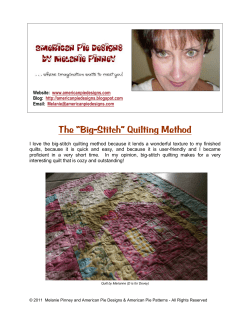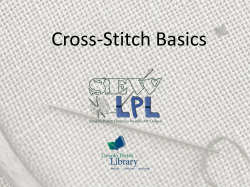
Hand-sewing Skills 320-13
Hand-sewing Skills 320-13 Pilot Edition The skill of hand-sewing will play an integral part of your sewing. Some hand-sewing stitches may be temporary, such as basting, while others will be permanent, such as hemming and decorative stitching. Learning to choose and use the best method of hand-sewing for your fabric and item requires both understanding and experience. When hand-sewing is well coordinated and well done, the items constructed will have a final look of quality. The equipment needed for hand-sewing is simple. Basically, it includes needles, thread, scissors, and pins. Some may also choose to use a thimble and/or beeswax. Needle Select the needle and thread suitable for your fabric and the type of hand-sewing you are going to do. The needle should be small enough so that it slips through the fabric easily and does not leave holes unfilled by the thread. Sharps and embroidery needles are basic to most hand-sewing. For basting, the longer milliner’s needles permit more stitches to be collected on the needle at one time. For the short stitches required in hand tailoring, betweens are best. Thread The thread should be compatible with you fabric weight, purpose, and color if you are doing permanent hand-sewing. If your fabric is made from cotton or wool, use cotton or polyester/cotton thread. If your fabric is made from a man-made fiber such as acrylic, polyester, or nylon, use polyester/cotton, polyester, or nylon thread. For silk fabric, use silk thread for hand-sewing. Silk thread should be used when pressing since it does not leave indentations or press marks. Thread is available in different sizes ranging from 100, which is an extremely fine thread, size 70, 60, and 50, which are the most used medium sizes, and size 8 or heavy duty cord and buttonhole twist. The color of the thread should match or be slightly darker than the fabric. Preparation Cut the thread at an angle to give an end which will be easy to insert in the needle. Pass the freshly cut end through the needle and knot that same end. This will maintain the twist and keep the thread smooth. Pulling the thread through beeswax will add strength and slipperiness. Beeswax should not be used if the fabric is sensitive to oil stains. In basting, the knot made can be visible; in permanent stitching, place the knot out of sight against and inside layer of the fabric. General Stitches Running stitch is a basic stitch used for basting, easing, gathering, mending, and seams where there will be no strain. Take several stitches forward, weaving the needle in and out of the fabric. The size of the stitch will be determined by the purpose of the stitching -- longer stitches for basting and shorter stitches where the sewing will be more permanent. Backstitching is a basic stitch with several variations. It is a strong hand-stitch useful for repairing seams and hard-to-reach areas. With the right sides of the fabric together, bring the needle up through the fabric layers. Insert the needle about 1/16 to 1/8 inch in back of where it came up, and bring it out again 1/16 to 1/8 inch forward. For each stitch, insert the needle at the end of the last stitch and bring it out ahead. Pick-stitch and prick-stitch are backstitches with the thread on the right side carried back only one or two fabric yarns before being inserted into the fabric. The pick-stitch is sewn through only the top layer of fabric to give a decorative, beadlike effect on the surface. The pick-stitch is used for applying zippers from the right side of a garment. It passes through all fabric layers. Overcasting is used to finish raw edges of delicate fabrics to prevent them from raveling. It was used for all fabrics that ravel before zigzag machines were available to the home sewer. Take diagonal stiches over the edge at a uniform space and depth. Overhand and whipstitch are close, tighter variations of overcasting. Both hold two finished edges together. The overhand stitch tends to be less conspicuous. For the overhand stitch, insert the needle at a diagonal through the back and front edges so the stitch itself is straight. For the whipstitch, insert the needle at a right angle so the stitches are slanted. Hemming Stitches Hemming stitches are used to secure a garment hem or item edge. Depending on the item and fabric, the choice will be either a flat or blind hemming technique. Slip-stitch is used for invisible finishing when there is a folded or turned edge. It might be used for hemming or for closing the opening of a pillow or stuffed toy. Slip the needle through the edge of the fold then pick up a yarn of the under fabric. Space the stitches evenly, making sure that the thread does not show or cause an indentati on on the right side. Hemming stitch is used when the hem is finished with a seam binding. Take a one or two-yarn stitch in the garment, then bring the needle through the edge of the seam binding. The stitches which pass over the seam binding edge to the garment may be slanted (quick, but less durable) or vertical (more durable and stable). The stitch should be inconspicuous from the right side and not drawn or pulled too tightly. Blind-stitch hemming is inconspicuous from both the right side and the hem side of a garment. First, finish the raw edge of the hem or facing without folding it. Then, 1/8 to 1/4 inch from the hem edge, alternate small, horizontal stitches in between the garment and the hem laving about 1/4 to 1/2 inch between stitches. Do not pull stitches tightly. Stitches or indentations should not be visible from the right side. This stitch permits pressing without forcing the hem edge to cause a ridge visible from the right side. Use this stitch with non-stretchy fabric. Catch-stitch is used like the blind-stitch except it is flexible and suitable for use with non-raveling, stretchy fabrics. It also permits pressing, without the hem edge causing a ridge visible from the right side. The stitch itself is taken in the opposite direction to the line of needle movement. Working in a left to right direction, in between the hem and the garment, 1/8 to1/4 inch from the hem edge, take a small stitch in the hem. Then move diagonally to the right to take the next stitch in the garment. Alternate stitching in this zigzag fashion. Keep stitches loose to retain flexibility of hem edge. Tacks Tacks are hand stitches done during construction or in marking. Marking or Tailor’s tack are used to transfer construction details and matching points from the pattern to the cut section of fabric. Start with a long length of double, unknotted thread. Take a small stitch on pattern line through pattern and fabric. Pull needle and thread through, leaving 1” thread end. Take similar stitches about every 2-3” leaving thread slack in between. Cut threads and gently pull pattern off of fabric taking care not to pull off thread markings. Thread can be looped in the same spot for marking dots/symbols, but loops must be cut before pattern is removed. Bar tack is a reinforcement tack used at points of strain, such as buttonholes or corners of pocket. Fasten thread and bring needle through to the right side. Take two or three long stitches – the length that the bar tack needs to be, in the same place. Catching the fabric underneath, work closely spaced blanket stitches around the thread to cover the long stitches. French tack is similar to a bar tack. Its’ purpose is to connect two separate garment sections such as the bottom edge of a coat to the bottom edge of the lining, while still allowing independent movement of each piece. If performing at the hem edge, take a small stitch through the top of garment hem edge, then another small stitch directly across from it in the lining leaving 1 – 2 inches of slack in thread between stitches. Repeat 3-4 times. Then work closely spaced blanket stitches over the threads. Decorative Stitches There are several decorative stitches. Here are a few common ones to integrate into your sewing. Blanket Stitch is often used to cover fabric edges decoratively. It is traditionally an embroidery stitch but can also be used in garment construction. For the first, and each succeeding stitch, insert needle through fabric from right side and bring out at edge. Keeping thread from the previous stitch under the point of the needle, draw needle through, forming stitch over edge. Buttonhole Stitch is used as a decorative stitch at the edge of the fabric and in the making of hand-worked buttonholes. In doing the stitch, work from right to left, with the point of the needle toward you and the edge of the fabric away from you. Fasten your thread and bring out above the edge. Loop thread from previous stitch to left, then down to right. Insert the needle from the underside, keeping looped thread under both point and eye of needle. Pull the needle out through the fabric, then away from you to place the purl of the stich on the fabric’s edge. For a buttonhole, stitches should be 1/8” deep with no space between. Chain Stitch is a continuous series of looped stitches that form a decorative chain. Work from right to left. Fasten the thread and bring up to the right. For each stitch, loop the thread around, insert needle just behind where thread emerges and bring it up, over the looped thread a stitch length in front of that point. Pull thread through, to the left, to form looped stitch. References: Reader’s Digest: Complete guide to Sewing. (2005). The Reader’s Digest Association (Canada) Ltd. Montreal – Pleasantville, NY. Revised 2013, by Pamela Rose, 4-H Youth Development Specialist in Family & Consumer Science and Expressive Arts. Originally prepared by Ardis Koester, Extension Textiles and Clothing Specialist emeritus. Illustrations reprinted with permission of Readers’ Digest. ` Oregon State University Extension Service offers educational programs, activities, and materials without discrimination based on age, color, disability, gender identity or expression, marital status, national origin, race, religion, sex, sexual orientation, or veteran’s status. Oregon State University Extension Service is an Equal Opportunity Employer.
© Copyright 2025









